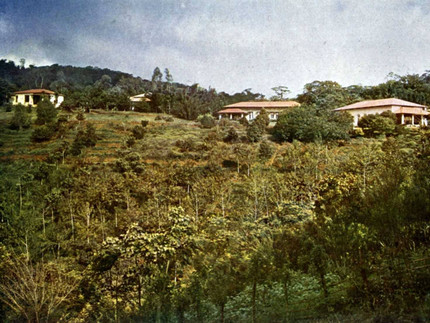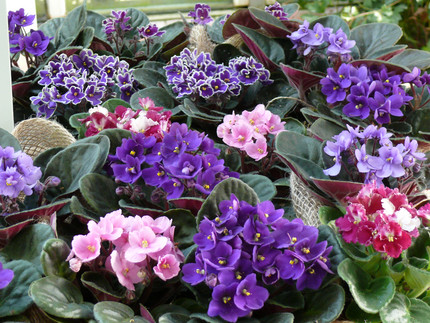Colonial experimental garden in Amani – Tanzania
The German colonies aimed to be made economically profitable through the establishment of plantations for the exploitation of plant resources. In 1902, the Biological Agricultural Institute in Amani in the Usambara Mountains in present-day Tanzania (formerly the colony of "German East Africa") was founded to develop the knowledge required for this purpose.1
Covering an area of about 250 hectares, the institute was used entirely to support the plantation economy and was designed to generate economic profits for the colony.1,2 Research focused on plant physiology, suitable cultivation methods, and entomology, as well as on possible medicinal uses of African plants.3 After World War I, the station was turned over to the British until Tanzania's independence, who continued to tolerate the work of some German botanists. Large parts of the plant collections of that time were relocated, split up and only a part of the original institute still exists as a nature reserve.1,4 Scientific activities have largely stopped and only a few staff members still take care of the maintenance of the buildings and the landscape.5
Botanist Hermann Wendland established the genus Saintpaulia in 1893.6 He named it after its so-called "discoverer," the German colonial official in East Africa, Adalbert Emil Walter Le Tanneux of Saint Paul-Illaire (1860-1940) and his father, Ulrich Maximilian Le Tanneux of Saint-Paul-Illaire (1833-1902). Both were Prussian military officers and very interested in botany. At the same time, that his son was engaged in botany in East Africa, his father and others founded the German Dendrological Society, of which he was the first president. It still exists today.7,8 The genus Saintpaulia, on the other hand, is lately no longer regarded as independent; the species are now included in the genus Streptocarpus (rotary fruit).9
References
[1] Wendt, Samuel E. (2013): Masterarbeit: Kolonialbotanik und die Verwertung tropischer Nutzpflanzen. Zur Bedeutung des Kautschuks im Kaiserreich, 1880 - 1914. Europa-Universität Viadrina Frankfurt (Oder). Frankfurt (Oder).
[2] Geißler, P. Wenzel; Gerrets, Rene; Kelly, Ann H.; Mangesho, Peter (2020): Amani - Auf den Spuren einer kolonialen Forschungsstation in Tansania. Bielefeld, Germany.
[3] Geißler, P. Wenzel; Kelly, Ann H. (2016): Field station as stage: Re-enacting scientific work and life in Amani, Tanzania. In: Social studies of science 46 (6), S. 912–937. DOI: 10.1177/0306312716650045.
[4] Nagel, Jürgen G. (2013): Die Kolonie als wissenschaftliches Projekt. Forschungsorganisation und Forschungspraxis im deutschen Kolonialreich. Habilitationsschrift. Fernuniversität, Hagen. Fakultät für Kultur- und Sozialwissenschaften. Online verfügbar unter www.academia.edu/41830319/Die_Kolonie_als_wissenschaftliches_Projekt_Forschungsorganisation_und_Forschungspraxis_im_deutschen_Kolonialreich, zuletzt geprüft am 10.02.2023.
[5] Ghyselen, Astrid; Geissler, Paul Wenzel; Lagae, Johan; Mangesho, Peter E. (2017): Scenes of Amani, Tanzania: Biography of a postcolonial landscape. In: Journal of Landscape Architecture 12 (1), S. 6–17. DOI: 10.1080/18626033.2017.1301285.
[6] Burkhardt, Lotte (2018): Verzeichnis eponymischer Pflanzennamen. Eine Sammlung eponymischer, biografischer und bibliografischer Angaben zu Ehrungen in der Pflanzenwelt. Botanic Garden and Botanical Museum Berlin, Freie Universität Berlin.
[7] Ulrich Maximilian Le Tanneux von Saint-Paul-Illaire. Wikipedia. https://de.wikipedia.org/wiki/Ulrich_Maximilian_Le_Tanneux_von_Saint-Paul-Illaire, zuletzt geprüft am 27.3.2023.
[8] Walter von Saint Paul-Illaire. Wikipedia. de.wikipedia.org/wiki/Walter_von_Saint_Paul-Illaire, zuletzt geprüft am 27.3.2023.
[9] Nishii, Kanae et al. (2015): Streptocarpus redefined to include all Afro-Malagasy Gesneriaceae: Molecular phylogenies prove congruent with geographical distribution and basic chromosome numbers and uncover remarkable morphological homoplasies. Taxon 64(6): 1243-1274.


